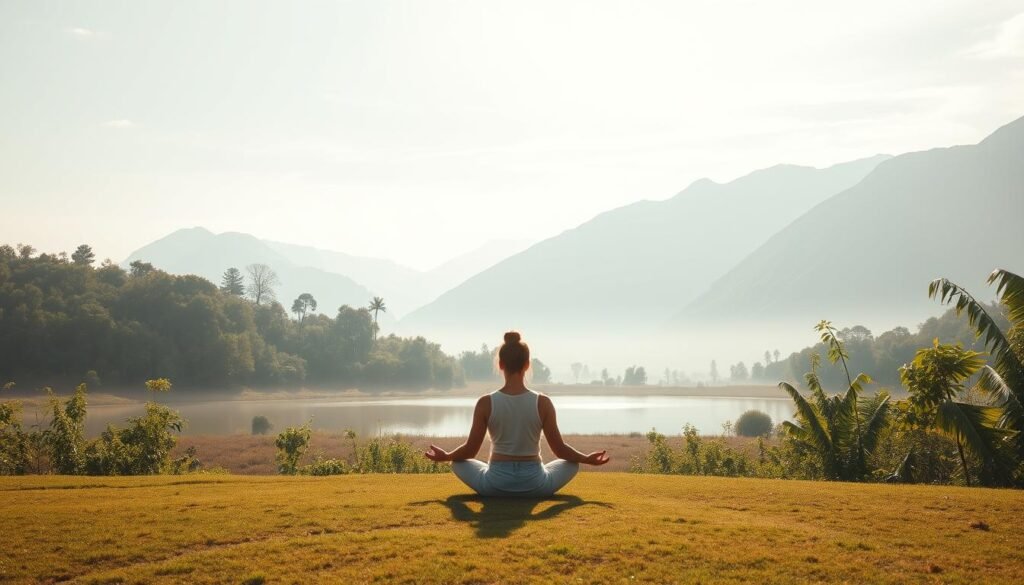Did you know that practicing mindfulness can significantly reduce stress and anxiety? In today’s fast-paced world, achieving a balanced mind is more crucial than ever. Mindfulness, a concept rooted in meditation, has gained popularity for its numerous benefits for both mental and physical health.
According to Jon Kabat-Zinn, mindfulness is “the awareness that arises from paying attention on purpose, in the present moment, non-judgmentally.” This practice encourages individuals to be fully engaged in the current moment, fostering a deeper sense of self-awareness and calm.
This article will introduce you to simple mindfulness techniques that can help you achieve a more balanced and peaceful state of mind.
Key Takeaways
- Understanding the concept of mindfulness and its benefits.
- Learning simple mindfulness techniques for daily practice.
- Discovering how mindfulness can improve mental and physical health.
- Exploring the connection between mindfulness and meditation.
- Practical tips for incorporating mindfulness into your daily routine.
What is Mindfulness?
Mindfulness is more than just a buzzword; it’s a practice rooted in being present and aware. As we delve into the world of mindfulness, understanding its core definition and the importance of being present becomes crucial.
The Importance of Being Present
Being present is at the heart of mindfulness. It’s about letting go of distractions and focusing on the here and now. This practice can have a significant impact on mental health by reducing stress and anxiety.
When we are present, we are more likely to engage fully with our experiences, leading to a more authentic and fulfilling life. This presence can enhance our self-care practices, allowing us to better understand our needs and emotions.
Definition of Mindfulness
Mindfulness is defined as the practice of being fully present and aware of one’s experiences without being overly reactive or judgmental. It involves cultivating awareness of the present moment, often through meditation or other practices.
The concept of mindfulness has been extensively studied and popularized by researchers like Jon Kabat-Zinn, who developed the Mindfulness-Based Stress Reduction (MBSR) program. According to Kabat-Zinn, mindfulness is about paying attention in a particular way: on purpose, in the present moment, and non-judgmentally.
| Mindfulness Aspect | Benefit | Impact |
|---|---|---|
| Being Present | Reduces Stress | Improves Mental Health |
| Non-Judgmental Awareness | Enhances Emotional Regulation | Betters Self-Care |
| Focused Attention | Improves Concentration | Boosts Productivity |
In conclusion, mindfulness is a powerful practice that can transform our lives by making us more present and aware. By understanding its definition and importance, we can begin to appreciate its benefits for our mental health and overall well-being.
Benefits of Mindfulness
The benefits of mindfulness are multifaceted, ranging from reduced stress to enhanced emotional regulation. By practicing mindfulness, individuals can experience significant improvements in both their mental and physical health.
Mental Health Improvements
Mindfulness has been shown to have a positive impact on mental health by reducing symptoms of anxiety and depression. Regular mindfulness practice can lead to improved emotional regulation and a greater sense of well-being.
- Reduced stress and anxiety
- Improved mood
- Enhanced cognitive function
Studies have demonstrated that mindfulness-based interventions can be effective in reducing symptoms of mental health disorders. For example, mindfulness-based stress reduction (MBSR) programs have been shown to decrease symptoms of anxiety and depression in both healthy individuals and those with chronic illnesses.

Physical Health Advantages
In addition to its mental health benefits, mindfulness has been linked to several physical health advantages. These include lower blood pressure, reduced chronic pain, and a stronger immune system.
- Lower blood pressure
- Reduced chronic pain
- Improved sleep quality
Research has shown that regular mindfulness practice can lead to these physical health benefits by reducing inflammation and improving cardiovascular health.
Enhanced Emotional Regulation
Mindfulness practice is also associated with enhanced emotional regulation, allowing individuals to better manage their emotions and respond to challenging situations more effectively.
By cultivating mindfulness, individuals can develop a greater awareness of their thoughts and emotions, enabling them to respond to stressful situations more mindfully and reduce the risk of emotional overwhelm.
Simple Mindfulness Techniques
Mindfulness practices, such as walking meditation and mindful breathing, offer a path to a more balanced life. These simple yet effective techniques can be easily integrated into daily routines, promoting a sense of calm and clarity.
Mindful Breathing
Mindful breathing is a fundamental technique that involves focusing on the breath to cultivate mindfulness. To practice, find a quiet space, sit comfortably, and bring your attention to your breath. Notice the sensation of the air entering and leaving your nostrils.
- Take slow, deep breaths, feeling the breath fill your lungs.
- When your mind wanders, gently bring your focus back to your breath.
- Start with short sessions, such as 5-10 minutes, and gradually increase the duration.
Mindful breathing can be practiced anywhere, making it a versatile tool for reducing stress and increasing mindfulness throughout the day.
Body Scan Meditation
Body scan meditation involves paying attention to different parts of your body, often starting from the toes and moving up to the head. This practice helps in releasing physical tension and promoting relaxation.
- Lie down or sit comfortably, closing your eyes.
- Bring your attention to your toes, noticing any sensations or feelings.
- Gradually move your focus up through your body, releasing tension as you go.
Regular practice of body scan meditation can lead to improved body awareness and reduced stress levels.
Walking Meditation
Walking meditation combines physical movement with mindfulness, encouraging a deeper connection with your surroundings. To practice, choose a quiet path and walk slowly, paying attention to the sensation of your feet touching the ground.
- Notice the movement of your legs and the rhythm of your breath.
- Be aware of your surroundings, observing sights and sounds without judgment.
- Use this practice to cultivate mindfulness in motion, enhancing your sense of presence.
Walking meditation can be a refreshing way to incorporate mindfulness into your daily routine, especially when combined with yoga or other physical activities.
Integrating Mindfulness in Daily Life
By weaving mindfulness into the fabric of daily life, individuals can experience profound benefits. Mindfulness is not limited to formal meditation practices; it can be incorporated into various daily activities, enhancing overall well-being.
Morning Mindfulness Rituals
Starting the day with mindfulness can set a positive tone. Simple practices like mindful breathing or a short meditation session can help in cultivating a sense of calm and clarity. To establish a morning mindfulness ritual, begin by setting aside a few minutes each morning to sit quietly, focus on your breath, and observe your thoughts without judgment.

Mindful Eating Practices
Mindful eating involves paying full attention to the experience of eating and drinking. It encourages a slower, more deliberate pace, allowing for a greater appreciation of the food’s taste, texture, and aroma. To practice mindful eating, try to eat without distractions, savor each bite, and listen to your body’s hunger and fullness cues.
Evening Reflection
Engaging in evening reflection can be a powerful way to unwind and process the day’s events. This can involve journaling, a short meditation, or simply reflecting on the day’s experiences and gratitudes. By incorporating this practice into your daily routine, you can cultivate a greater sense of closure and prepare your mind and body for rest.
Integrating mindfulness into daily life is a journey that requires patience, consistency, and self-compassion. By incorporating mindfulness exercises and meditation into daily routines, individuals can experience a more balanced and fulfilling life.
Mindfulness in Work Environments
As workplaces evolve, incorporating mindfulness techniques has become vital for improving job satisfaction and productivity. Mindfulness has been shown to have a positive impact on both employees and employers by reducing stress and enhancing focus.
Techniques for Reducing Stress
One of the primary benefits of mindfulness in the workplace is its ability to reduce stress. Techniques such as mindfulness meditation can help employees manage their workload more effectively. According to a study, regular mindfulness practice can lead to a significant reduction in stress levels. “Mindfulness is not just a practice, it’s a way of being that can transform the workplace,” says a mindfulness expert.
Mindfulness practices, such as deep breathing exercises and body scan meditation, can be easily integrated into the workday. These practices not only reduce stress but also improve overall mental health.
Enhancing Focus and Productivity
Mindfulness is also known to enhance focus and productivity. By being more present and aware, employees can manage their tasks more efficiently. A mindful approach to work involves being fully engaged in the task at hand, which can lead to higher quality work and greater job satisfaction.
Simple mindfulness exercises, such as taking a few minutes to focus on breathing or going for a mindful walk, can significantly improve an employee’s ability to concentrate and stay focused.
“The key to improving productivity is not about working more hours, but about being more present and focused during the workday.”
Key Takeaways
- Mindfulness reduces stress and improves mental health.
- Regular mindfulness practice enhances focus and productivity.
- Simple mindfulness exercises can be easily integrated into the workday.
Overcoming Common Mindfulness Obstacles
Common hurdles such as distractions and self-judgment can impede mindfulness practice, but there are strategies to overcome these challenges. As individuals cultivate mindfulness, they may encounter various obstacles that can be addressed with the right approaches, ultimately leading to effective stress relief.
Dealing with Distractions
Distractions are a common challenge when practicing mindfulness. To overcome this, it’s helpful to create a conducive environment for practice. This can involve setting aside a quiet, dedicated space for mindfulness exercises.
Another strategy is to use guided meditations, which can help maintain focus. Additionally, being patient and acknowledging distractions without judgment can aid in refocusing one’s attention.

Addressing Self-Judgment
Self-judgment can be a significant barrier to effective mindfulness practice. Practitioners can address this by cultivating a non-judgmental awareness of their thoughts and feelings. Recognizing that judgments are mere mental constructs, rather than reflections of reality, can help mitigate their impact.
| Strategy | Description | Benefit |
|---|---|---|
| Meditation | Regular practice of meditation | Enhances focus and calmness |
| Non-Judgmental Awareness | Acknowledging thoughts without judgment | Reduces self-criticism and promotes acceptance |
| Guided Exercises | Using guided mindfulness exercises | Helps maintain focus and reduces distractions |
By employing these strategies, individuals can overcome common obstacles and deepen their mindfulness practice, leading to greater stress relief and overall well-being.
Mindfulness Resources and Tools
Exploring mindfulness resources can be a game-changer for those seeking a more balanced life. With the numerous tools available, individuals can find the right fit to enhance their mindfulness practices and achieve a state of relaxation.
Mindfulness resources come in various forms, including digital apps, books, online courses, and workshops. These resources provide guidance and structure, helping individuals deepen their practice and integrate mindfulness into daily life.
Recommended Books and Apps
For those looking to start or enhance their mindfulness journey, several books and apps are highly recommended. Some popular mindfulness books include “The Miracle of Mindfulness” by Thich Nhat Hanh and “Wherever You Go, There You Are” by Jon Kabat-Zinn. These books offer insights and practical advice on incorporating mindfulness into daily activities.
- Headspace: A popular app known for its guided meditation sessions and personalized mindfulness plans.
- Calm: An app that offers a variety of relaxation techniques, including meditation and sleep stories.
- Insight Timer: A free app with a vast library of guided meditations and a timer for tracking personal practice.
Online Courses and Workshops
For a more structured approach, online courses and workshops can be incredibly beneficial. Platforms like Coursera, Udemy, and edX offer courses on mindfulness and meditation, often taught by experienced instructors.
- Mindfulness-Based Stress Reduction (MBSR): A program developed by Jon Kabat-Zinn, focusing on reducing stress through mindfulness techniques.
- Mindfulness Courses on Udemy: A range of courses covering various aspects of mindfulness, from basics to advanced practices.
By leveraging these mindfulness resources and tools, individuals can find the support they need to maintain a consistent practice and enjoy the benefits of relaxation and improved well-being.
Mindfulness for Children and Teens
As children and teens navigate the challenges of growing up, mindfulness can provide them with valuable coping strategies. Mindfulness practices have been shown to help younger individuals develop emotional regulation, improve their focus, and enhance their overall well-being.
Techniques for Younger Audiences
Adapting mindfulness techniques for children and teens involves making the practices engaging and accessible. Mindfulness exercises such as yoga and guided meditations can be particularly effective. For younger children, games and activities that promote mindfulness can be integrated into daily routines.
For teens, mindfulness can be a powerful tool for managing stress and anxiety. Techniques such as mindful breathing, body scan meditation, and walking meditation can be adapted to suit their needs and preferences.

Creating a Mindful Family Environment
Creating a mindful family environment involves incorporating mindfulness practices into daily life. Parents and caregivers can model mindful behavior, encouraging children to follow suit. Simple practices such as mindful eating, family meditation sessions, and mindful communication can foster a more mindful home.
By making mindfulness a family affair, parents can help their children develop healthy habits and a positive relationship with mindfulness that can last a lifetime.
- Practice mindfulness together as a family.
- Encourage children to express their feelings and emotions.
- Model healthy coping mechanisms.
Mindfulness is not just a practice but a way of living that can benefit the entire family. By embracing mindfulness, families can cultivate a more compassionate, understanding, and peaceful home environment.
Continuing Your Mindfulness Journey
As you progress on your mindfulness path, setting realistic goals is crucial for maintaining a consistent practice. This involves understanding your current level of commitment and gradually increasing it over time. By doing so, you can cultivate a deeper sense of self-awareness and improve your mental health.
Practical Goal Setting
Begin by identifying achievable milestones, such as dedicating a specific time each day to meditation or practicing mindfulness during daily activities. Regularly reviewing and adjusting these goals will help you stay on track and foster a sense of accomplishment.
Building a Mindful Community
Surrounding yourself with like-minded individuals can significantly enhance your mindfulness practice. Joining local meditation groups or online forums can provide valuable support and motivation. Engaging with others who share your interest in mental health and meditation can also lead to meaningful connections and a greater sense of belonging.
By combining realistic goal setting with a supportive community, you can continue to grow and deepen your mindfulness practice, leading to lasting improvements in your overall well-being.
FAQ
What is mindfulness and how can it benefit my mental health?
How can I start practicing mindfulness in my daily life?
Can mindfulness be practiced in the workplace, and what are the benefits?
How can I overcome common obstacles to mindfulness practice, such as distractions and self-judgment?
What resources are available to support my mindfulness practice?
Can mindfulness be taught to children and teens, and how can I adapt it for younger ages?
How can I continue to deepen my mindfulness practice over time?
What is the role of yoga in mindfulness practice?
How can I incorporate mindfulness into my daily routines, such as eating and daily activities?
Prabir Dutta
Prabir Dutta is a passionate digital creator, affiliate marketer, and wellness enthusiast who simplifies complex topics like AI tools, Vastu, pet care, and modern living. With a keen eye for SEO, tech trends, and everyday health solutions, he writes to empower readers with actionable, smart-living insights. When not curating content across his network of niche blogs, Prabir enjoys exploring new digital tools that make life easier and more efficient.






